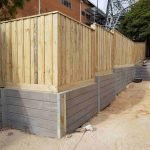Introduction
In the complex world of building and construction, task management acts as the backbone of effective ventures. This is especially true in specialized fields like retaining wall construction, where knowledgeable specialists need to intertwine engineering expertise with innovative problem-solving to accomplish optimum outcomes. The expression "Successful Job Management by Proficient Retaining Wall Contractors" encapsulates the essence of what it takes to ensure that these jobs are completed on time, within budget plan, and to the highest requirements of quality.
Retaining walls play a vital role in stabilizing soil and preventing disintegration. Whether they are made from timber sleeper, concrete sleeper, and even H beam, their design and building need careful preparation and execution. This article will look into different aspects of task management particular to retaining wall building, highlighting the importance of professionalism and skill in achieving success.
Successful Job Management by Skilled Retaining Wall Contractors
Successful job management in retaining wall jobs depends upon a number of essential factors: appropriate preparation, skilled labor, reliable communication, and rigorous quality control. A skilled professional can navigate these complexities effectively, ensuring that every stage of the project lines up with both client expectations and regulative requirements.
Understanding Retaining Walls
What Are Retaining Walls?
A retaining wall is a structure created to hold back soil or rock from a building website. They come in numerous products-- timber sleeper, concrete sleeper, or steel structures like H beams-- each providing distinct advantages based upon the task's requirements.

Types of Retaining Walls
Gravity Walls: These depend on their weight to withstand pressure from behind. Cantilever Walls: These utilize take advantage of to stand against lateral forces. Sheet Stack Walls: Ideal for soft soils; they interlock vertical sheets driven into the ground. Anchored Walls: Supported with cable televisions or rods protected in the soil behind them.The Function of Experienced Contractors
Why Select Professional Contractors?
Choosing professional specialists for your retaining wall job ensures that you receive professional suggestions tailored to your particular needs. From selecting suitable materials like lumber or concrete sleepers to understanding local guidelines, their know-how proves invaluable.
Expertise in Product Selection
Different jobs demand different products:
- Timber Sleeper Walls: Typically used for ornamental functions; visually pleasing but less durable. Concrete Sleeper Walls: More robust than lumber; ideal for larger tasks needing considerable strength. H Beam Structures: Excellent for sturdy applications where extra support is necessary.
Planning Stage: The Heartbeat of Task Management
Setting Clear Objectives
Establishing clear objectives sets the phase for success. What do you want your retaining wall to achieve? Disintegration control? Visual appeal? Structural stability? Defining these goals early assists guide decision-making throughout the project.

Budgeting Wisely
Creating a reasonable budget is necessary for any job's success. Include expenses for products (like timber sleeper or concrete sleeper), labor, equipment leasing, permits, and unanticipated contingencies.
Communication Methods for Success
The Value of Open Communication
Effective interaction amongst staff member fosters a collective environment favorable to problem-solving and development. Routine conferences should be set up at key milestones to evaluate progress and attend to any concerns promptly.
Utilizing Innovation for Better Communication
Today's technology can enhance interaction significantly:
- Project management software application can track timelines and budget plans efficiently. Mobile apps can assist in real-time updates amongst staff member on-site.
Risk Management Techniques
Identifying Possible Threats Early On
Understanding possible dangers-- including climate condition affecting excavation work or hold-ups in product supply-- is crucial for maintaining timelines and budgets.
Developing Mitigation Strategies
Once threats are recognized, establishing techniques to mitigate them is vital. This may involve having backup suppliers or scheduling work throughout seasons with favorable weather condition conditions.
Execution Stage: Bringing Plans to Life
Quality Control Measures During Construction
Maintaining high requirements throughout construction makes sure sturdiness and longevity:
- Regular examinations ought to be carried out at each phase. Quality materials should be sourced-- whether you opt for timber sleeper or concrete options-- to make sure structural integrity.
Efficient Resource Management
Skilled credible wall services specialists stand out at resource management-- enhancing labor hours while decreasing waste is key to remaining within budget and schedule.
Post-Construction Stage: Final Touches & Maintenance Planning
Conducting Thorough Inspections After Completion
Final evaluations should verify that everything satisfies both customer expectations and regulatory standards before progressing with any landscaping or completing touches.
Creating an Upkeep Prepare for Longevity
Educating clients on how best to keep their brand-new retaining walls is similarly crucial as the building itself. Regular maintenance checks can prevent future concerns associated with erosion or structural failure.
FAQs
1. What kinds of products are best matched for maintaining walls?
The option depends on your specific needs:
- For aesthetic appeals: Lumber sleepers may be preferable. For resilience under pressure: Concrete sleepers are an outstanding option.
2. The length of time does it take to develop a keeping wall?
The timeline differs based on size and intricacy but usually ranges from several days to numerous weeks.
3. Do I require a permit for constructing a maintaining wall?
Yes, many municipalities need authorizations due to zoning laws focused on preventing water overflow issues.
4. Can I build a retaining wall myself?
While do it yourself jobs can be gratifying, employing professional contractors often guarantees security, compliance with policies, and quality workmanship.
5. How do I know if my soil requires stabilization?
Signs include relentless flooding after rain or visible disintegration with time-- professional evaluations can offer clarity here.
6. What upkeep do keeping walls require?
This includes regular examinations for cracks or bulging areas along with ensuring drain systems remain clear of debris.
Conclusion
Navigating the complexities related to "Effective Job Management by Experienced Retaining Wall Professionals" requires an understanding of engineering principles combined with useful experience in handling varied groups effectively. By emphasizing correct preparation, skilled labor choice-- consisting of options between timber sleeper and concrete sleeper options-- and strenuous interaction methods throughout all stages-- from preliminary preparation through post-construction maintenance-- you set yourself up not just for conclusion however likewise long-lasting success in ensuring structural stability versus nature's challenges!
In short, whether you're an ambitious DIY enthusiast checking out self-built options or a seasoned residential or commercial property developer seeking professional assistance-- embracing these principles will certainly lead you toward more effective ventures in building reliable keeping walls!